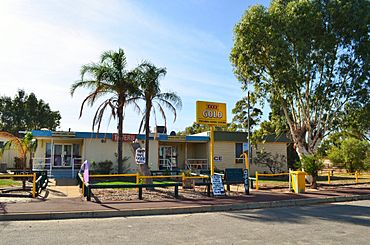Eneabba, Western Australia facts for kids
Quick facts for kids EneabbaWestern Australia |
|
|---|---|

Eneabba Sands Tavern, 2014.
|
|
| Established | 1961 |
| Postcode(s) | 6518 |
| Elevation | 99 m (325 ft) |
| Area | [convert: needs a number] |
| Location | |
| LGA(s) | Shire of Carnamah |
| State electorate(s) | Moore |
| Federal Division(s) | Durack |
Eneabba is a small town in Western Australia. It is located about 278 kilometres (173 mi) north of Perth, the state capital. You can find Eneabba along the Brand Highway.
This area is well-known for its amazing display of wildflowers that bloom every spring. It is also an important site for mining. The town is home to a large facility run by Iluka Resources, which processes mineral sands.
Contents
Discovering Eneabba: A Look at Its Past
Eneabba has an interesting history, starting with early European explorers.
Early Explorers and Settlers
The first European to visit the Eneabba area was George Grey in 1839. He was on an expedition along the west coast. Grey and his team had to walk through the area after their boats were lost. On April 11, Grey found and named the Arrowsmith River. He named it after John Arrowsmith, a famous mapmaker from England.
Later, in 1846, two government surveyors, Augustus Charles Gregory and Francis Thomas Gregory, visited the area. They were looking for new land for farming. They camped at Eneabba Springs on September 14, 1846. This spot is about 14 kilometres (8.7 mi) east of where Eneabba is today.
The first settler in the area arrived in 1870. His name was William Horsley Rowland. He came from Greenough and leased a large area of land, about 3,000 acres (1,200 ha), at Eneabba Springs. He made a living by looking after sheep, trapping wild horses and pigs, and hunting for food.
How Eneabba Became a Town
In the 1950s, the land around Eneabba, known as the Eneabba sandplain, was opened up for farming. This was part of a project to create new farms for soldiers who had returned from war. Because of these new farms, there was a need for a town nearby.
So, the town of Eneabba was officially created on January 27, 1961. The name "Eneabba" comes from an Aboriginal name for Eneabba Springs. It means "ground spring," referring to the natural springs found there. This was also the site of William Rowland's first home.
Eneabba's Industries and Development
Eneabba plays a role in Australia's mining and energy industries.
Mineral Sands Mining
A big part of Eneabba's economy is mineral sands mining. The Iluka Resources company has a large mine here. Mineral sands contain valuable minerals like zircon and titanium, which are used in many products, from paints to ceramics.
To help with the mining, a railway line was built. The Dongara–Eneabba railway line opened in April 1976. This line connects the Iluka Resources mine in Eneabba to the main Midland railway line at Dongara. This helps transport the mined minerals.
Renewable Energy: Wind Farm
Eneabba is also part of Australia's move towards cleaner energy. The Warradarge Wind Farm is being built southeast of the town. Wind farms use large turbines to capture wind energy and turn it into electricity. This is a great way to produce power without harming the environment as much as other methods.
Climate in Eneabba
Eneabba has a type of weather called a Mediterranean climate#Hot-summer mediterranean climate. This means it has hot, dry summers and mild, wet winters. It's similar to the climate found in places around the Mediterranean Sea.
| Climate data for Eneabba (1981–2010 normals; extremes 1972–2017) | |||||||||||||
|---|---|---|---|---|---|---|---|---|---|---|---|---|---|
| Month | Jan | Feb | Mar | Apr | May | Jun | Jul | Aug | Sep | Oct | Nov | Dec | Year |
| Record high °C (°F) | 47.3 (117.1) |
48.7 (119.7) |
44.9 (112.8) |
40.0 (104.0) |
36.1 (97.0) |
29.0 (84.2) |
29.3 (84.7) |
30.5 (86.9) |
35.4 (95.7) |
41.0 (105.8) |
45.2 (113.4) |
45.9 (114.6) |
48.7 (119.7) |
| Mean daily maximum °C (°F) | 36.3 (97.3) |
36.3 (97.3) |
33.6 (92.5) |
29.6 (85.3) |
24.5 (76.1) |
20.9 (69.6) |
19.6 (67.3) |
20.7 (69.3) |
23.2 (73.8) |
26.8 (80.2) |
30.3 (86.5) |
33.3 (91.9) |
27.9 (82.2) |
| Mean daily minimum °C (°F) | 18.6 (65.5) |
19.4 (66.9) |
18.1 (64.6) |
15.4 (59.7) |
12.4 (54.3) |
10.2 (50.4) |
8.9 (48.0) |
9.0 (48.2) |
9.8 (49.6) |
11.4 (52.5) |
14.0 (57.2) |
16.1 (61.0) |
13.6 (56.5) |
| Record low °C (°F) | 9.2 (48.6) |
8.8 (47.8) |
9.7 (49.5) |
7.6 (45.7) |
4.2 (39.6) |
1.7 (35.1) |
0.5 (32.9) |
2.3 (36.1) |
2.9 (37.2) |
3.4 (38.1) |
5.9 (42.6) |
7.5 (45.5) |
0.5 (32.9) |
| Average precipitation mm (inches) | 8.3 (0.33) |
15.3 (0.60) |
15.5 (0.61) |
22.4 (0.88) |
71.6 (2.82) |
88.0 (3.46) |
93.3 (3.67) |
75.4 (2.97) |
46.8 (1.84) |
22.8 (0.90) |
15.5 (0.61) |
10.4 (0.41) |
486.3 (19.15) |
| Average precipitation days | 1.5 | 2.1 | 2.9 | 5.1 | 10.2 | 12.8 | 14.7 | 13.4 | 10.7 | 6.4 | 4.2 | 2.4 | 86.4 |
| Average afternoon relative humidity (%) | 31 | 30 | 34 | 40 | 47 | 55 | 57 | 54 | 49 | 42 | 38 | 33 | 43 |
| Source: Bureau of Meteorology | |||||||||||||


